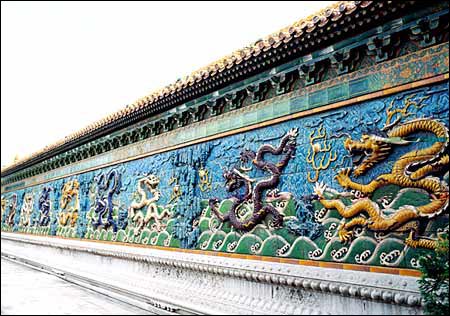Chinese Art of Tea;Tea Drinking in the Palace(茶文化在在皇家故宫中的地位)
Chinese Art of Tea中国茶艺随处可见;Tea Drinking in the Palace茶饮在皇家故宫中的地位
Chinese Art of Tea (Cha in Chinese) Drinking Wherever Chinese go, the custom of drinking tea follows. The Chinese were the first to discover the tea leaf, and have drunk tea for uncounted ages. When you arrive in the beautiful island of Taiwan, you may see some elderly gentlemen seated in twos and threes, perhaps in a temple up some old street...
China produces the widest variety of teas in the world. No wonder so many western tourists tend to get confused when they go to buy some souvenir tea to take home. One question inevitably arises: What makes one tea different from another?
Chinese merchants mark the distinction by sorting teas according to differences in processing. Basically, there are six categories: green tea, oolong, black tea, white tea, yellow tea and dark tea(黑茶). Of them, green tea, oolong and black tea are the three most popular ones.
Green Yea ("lv cha" in Chinese ) eaves still look naturally yellowish-green after they are processed, without fermentation. Leaves are first pan-fried in temperatures between 200 degrees Celsius and 260 degrees to kill an enzyme in the leaf that causes oxidation and discoloration. Then the leaves are rolled for shape and fired for drying. The finest green teas are usually dried by a hand-processing method. When the first harvest of green tea comes to Shanghai markets in early May, tea specialists often appear in tea shops to demonstrate the last step of processing: firing. The leaves are stirred by a skillful hand in a heated, large iron wok, leaving the leaves glossy. The Shanghai Friendship Store has had such an exhibition at its tea section on the ground floor in recent weeks. Green tea, in general, has a slightly sweet taste and pleasant aroma. A cup of fine green tea should be crystal clear with a light green hue. It should not be dull. In China, the three best-known green teas are Longjing (Dragon Wel), Huangshan Maofeng( Yellow Mountain Hairpoint) and Biluochun (Green Snail Spring).
Tea Drinking in the Palace (茶饮在故宫)

Tea has been the chief drink in China since ancient times, and tea drinking has been a custom for almost as long. Tea was popular in the Tang Dynasty. During the Ming and Qing Dynasties prominent officials and eminent people used tea drinking as an occasion to foster friendships and discuss poetry. Tea drinking was an important part of palace life.
The Forbidden City was the imperial palace of the Ming and Qing Dynasties. The tea drunk by the Royal Family was a tribute from the tea – growing provinces and was stored in the palace for use in all the halls. Its excellence and quality were beyond description. The numerous tea parties held in the palace related directly to civil affairs, education, and court rites.
Most tea parties in the Forbidden City were held in Wenhua Hall 文华殿 (the Hall of Literary Glory), Chonghua Palace 重华殿 (the Hall of Double Glory) or Qianqing Palace 乾清宫 (the Hall of Heavenly Purity).
Upon entering the Meridian Gate of the Imperial Palace, one came to the Gate of Supreme Harmony. East of the Gate of Supreme Harmony was an external courtyard that contained three buildings: The main hall, called the Hall of Literary Glory, was in front, the Hall of Main Respect was in the middle, and the Imperial Library was in the back. It was in these buildings that the Qing Dynasty emperors honored Confucius, listened to lectures with their ministers, and kept the Four Collections of Books. They were the cultural center of the Forbidden City, and tea was served whenever the emperors attended lectures.
As early as the Ming Dynasty, it became an important rite for tea to be served in the Hall of Literary Glory when the emperors listened to lectures. The Ming Dynasty emperors and their ministers attended lectures in this hall three times a month. A lecturer spoke first about literature, then about classics, and last about history. After the lecture, the emperor gave tea to the lecturer and his ministers. Tea was served so the lecturer could moisten his throat, but more importantly, as a symbol to encourage education.
History of tea in China(中国茶叶的历史)
Chinese tea culture
Introduction of Chinese Tea - 中国茶叶的介绍
Introduction of Chinese Tea - 中国茶叶的介绍2
Lu Yu and Chinese Tea Culture(陆羽和中国茶文化)
Chinese Tea Party:BeijingWuyutai Tea Shop(中国茶馆:吴裕泰茶馆)
Chinese Art of Tea;Tea Drinking in the Palace
Oolong Tea(乌龙茶)
Chinese Tea Classification(中国茶叶品种分类)
Chinese Tea culture and Chinese Tea History)
美国独立战争((American War of Independence)与波士顿茶叶事件(Boston Tea Party)
上一个:Chinese Tea Party:BeijingWuyutai Tea Shop(吴裕泰茶馆)
下一个:Oolong Tea(乌龙茶)
最新产品
最新资讯
- 武夷山小楼莲花茶会所里的"枫香兰韵肉桂茶" 2013-07-01
- 武夷山市钦品茶业有限公司(品牌:钦品) 2013-03-21
- “国八条”颁布,高档礼品茶销量下滑,市场更亲民 2013-03-02
- 遇林亭·观茶器建盏 2013-01-01
